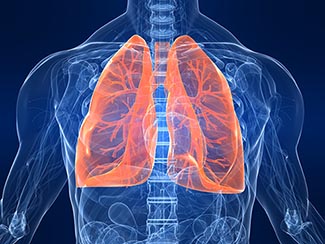 The key is something the researchers call mechanosensitive signaling of myofibroblasts. Myofibroblasts are cells responsible for wound healing in the body. In healthy tissues, myofibroblasts assist with wound repair then die in a pre-programmed process known as apoptosis. Fibrosis involving the lungs or other organs occurs when myofibroblasts fail to undergo apoptosis, resulting in a persistent repair process.
The key is something the researchers call mechanosensitive signaling of myofibroblasts. Myofibroblasts are cells responsible for wound healing in the body. In healthy tissues, myofibroblasts assist with wound repair then die in a pre-programmed process known as apoptosis. Fibrosis involving the lungs or other organs occurs when myofibroblasts fail to undergo apoptosis, resulting in a persistent repair process. Idiopathic pulmonary fibrosis, or IPF, occurs when lingering myofibroblasts secrete too much collagen in the air-sacs of the lungs, leading to scarring and stiffening of the surrounding matrix tissue. The researchers report that a protein called Rho kinase, known as ROCK, may contribute to the failure of myofibroblasts to undergo apoptosis. ROCK activates a mechanical signaling pathway causing the myofibroblasts to respond to mechanical cues. This promotes the survival of myofibroblasts and leads to more scar tissue formation, creating a vicious cycle of non-resolving repair.
“Fibrosis begets more fibrosis in a sort of feed-forward mechanism,” said Victor Thannickal, M.D., director of the Division of Pulmonary, Allergy and Critical Care Medicine and senior author of the study. “The ROCK pathway ultimately helps to keep the myofibroblasts alive and evade apoptosis.”
Previous studies have shown that cells have the ability to detect and respond to mechanical cues and changes in the stiffness of their immediate surroundings. A cell in contact with a soft matrix will respond differently than a cell in contact with a hard or stiff matrix.
“We can think of ROCK as a sort of enabler for myofibroblasts, sustaining them beyond normal timeframes and promoting mechanosensitive signaling,” said Yong Zhou, M.D., assistant professor in the Division of Pulmonary, Allergy and Critical Care Medicine and first author of the study. “The good news is this may also provide targets to interfere with the ROCK pathway and provide a viable therapy.”
One such possible therapy is a stroke drug called fasudil, which is a ROCK inhibitor. In animal models and in human IPF tissue studied in cell culture, fasudil blocked ROCK activation and promoted normal apoptosis of myofibroblasts.
In healthy cells, ROCK is believed to be responsible for smooth muscle function and controlling blood pressure. Blocking it systemically with fasudil may have some side effects, mostly a risk of a decrease in blood pressure. Zhou says this potential risk could be averted through the development of therapeutics to deliver the drug locally to the lung, perhaps inhaled.
“As this research continues and we learn more about the ROCK signaling pathway, we would anticipate the development of other ROCK inhibitors that might provide much the same mechanism of activity with less potential side effects,” said Zhou.
Thannickal says this approach may have utility in other diseases or conditions in which apoptosis of myofibroblasts is disrupted.
“Dysfunctional apoptosis is implicated in a number of diseases, such as cancer, autoimmune diseases and inflammatory and fibrotic diseases,” he said. “This discovery of the ROCK pathway and its specific role in mechanosensitive signaling and controlling apoptosis opens up intriguing new avenues for research.”
UAB is a leader in research and treatment for idiopathic pulmonary fibrosis. A member of the federally funded IPF Clinical Research Network, UAB is actively engaged in finding therapies for this condition that has no FDA-approved treatments.
In the United States, IPF is estimated to affect between 132,000 and 200,000 people, with approximately 50,000 new cases diagnosed each year. As many as 40,000 Americans die from IFP each year, with survival rates ranging from 2.5 to 3.5 years following diagnosis.
The study was funded by a grant from the National Heart, Lung and Blood Institute, one of the National Institutes of Health.